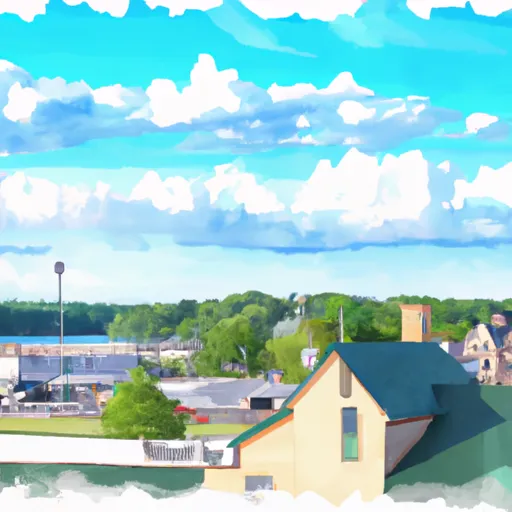-
 Snoflo Premium
Snoflo Premium
Get unlimited access to all our content
With no Ad interruptions! - Start Your Free Trial Login with existing account
Wales
Eden Index
Climate
7.3
•
Recreation
2.5
•
Community
•
Safeguard
3.8/10

Wales is a small township located in St. Clair County, Michigan. It experiences a humid continental climate, characterized by warm summers and cold winters. The average temperature ranges from 22°F (-5.5°C) in winter to 81°F (27°C) in summer. Precipitation is fairly evenly distributed throughout the year, with an annual average of around 32 inches (81 cm).
The hydrology constituents in Wales mainly revolve around the Pine River, which flows through the township. This river provides opportunities for fishing and boating enthusiasts, with various species such as trout, bass, and walleye present in its waters.
Outdoor recreation opportunities in Wales are abundant, with its picturesque landscapes offering a tranquil escape. The township is home to several parks and nature reserves, providing opportunities for hiking, camping, and wildlife observation. Wales also offers great possibilities for hunting, with its dense forests and diverse wildlife. Additionally, the region's proximity to the Great Lakes allows for water sports like swimming, kayaking, and paddleboarding.
Overall, Wales, Michigan offers a pleasant climate, accessible waterways, and diverse outdoor recreation opportunities, making it an attractive destination for nature lovers and outdoor enthusiasts.
What is the Eden Index?
The Snoflo Eden Index serves as a comprehensive rating system for regions, evaluating their desirability through a holistic assessment of climate health, outdoor recreation opportunities, and natural disaster risk, acknowledging the profound impact of these factors on livability and well-being.
Climate Health Indicator (CHI): 7.3
Wales receives approximately
831mm of rain per year,
with humidity levels near 81%
and air temperatures averaging around
9°C.
Wales has a plant hardyness factor of
6, meaning
plants and agriculture in this region thrive during a short period during spring and early summer. Most
plants will die off during the colder winter months.
By considering the ideal temperature range, reliable water supplies, clean air, and stable seasonal rain or snowpacks, the Climate Health Indicator (CHI) underscores the significance of a healthy climate as the foundation for quality living.
A healthy climate is paramount for ensuring a high quality of life and livability in a region, fostering both physical well-being and environmental harmony. This can be characterized by ideal temperatures, reliable access to water supplies, clean air, and consistent seasonal rain or snowpacks.
Weather Forecast
Streamflow Conditions
St. Clair-Detroit
Area Rivers
St. Clair-Detroit
Snowpack Depths
St. Clair-Detroit
Reservoir Storage Capacity
St. Clair-Detroit
Groundwater Levels
Recreational Opportunity Index (ROI): 2.5
The Recreational Opportunity Index (ROI) recognizes the value of outdoor recreational options, such as parks, hiking trails, camping sites, and fishing spots, while acknowledging that climate plays a pivotal role in ensuring the comfort and consistency of these experiences.
Access to outdoor recreational opportunities, encompassing activities such as parks, hiking, camping, and fishing, is crucial for overall well-being, and the climate plays a pivotal role in enabling and enhancing these experiences, ensuring that individuals can engage in nature-based activities comfortably and consistently.
Camping Areas
| Campground | Campsites | Reservations | Toilets | Showers | Elevation |
|---|---|---|---|---|---|
| North Park | 180 | 606 ft | |||
| Lighthouse County Park | 110 | 598 ft | |||
| Sanilac County Park - Forester | 190 | 606 ft | |||
| Stafford County Park | 73 | 587 ft | |||
| Algonac State Park | 400 | 582 ft | |||
| Wagener County Park | 96 | 593 ft | |||
| Lakeport State Park | 280 | 603 ft |
Nearby Fishing
Nearby Ski Areas
Catastrophe Safeguard Index (CSI):
The Catastrophe Safeguard Index (CSI) recognizes that natural disaster risk, encompassing floods, fires, hurricanes, and tornadoes, can drastically affect safety and the overall appeal of an area.
The level of natural disaster risk in a region significantly affects safety and the overall livability, with climate change amplifying these risks by potentially increasing the frequency and intensity of events like floods, fires, hurricanes, and tornadoes, thereby posing substantial challenges to community resilience and well-being.
Community Resilience Indicator (CRI):
The Community Resilience Indicator (CRI) recognizes that education, healthcare, and socioeconomics are crucial to the well-being of a region. The CRI acknowledges the profound impact of these elements on residents' overall quality of life. By evaluating educational resources, healthcare accessibility, and economic inclusivity, the index captures the essential aspects that contribute to a thriving community, fostering resident satisfaction, equity, and social cohesion.

